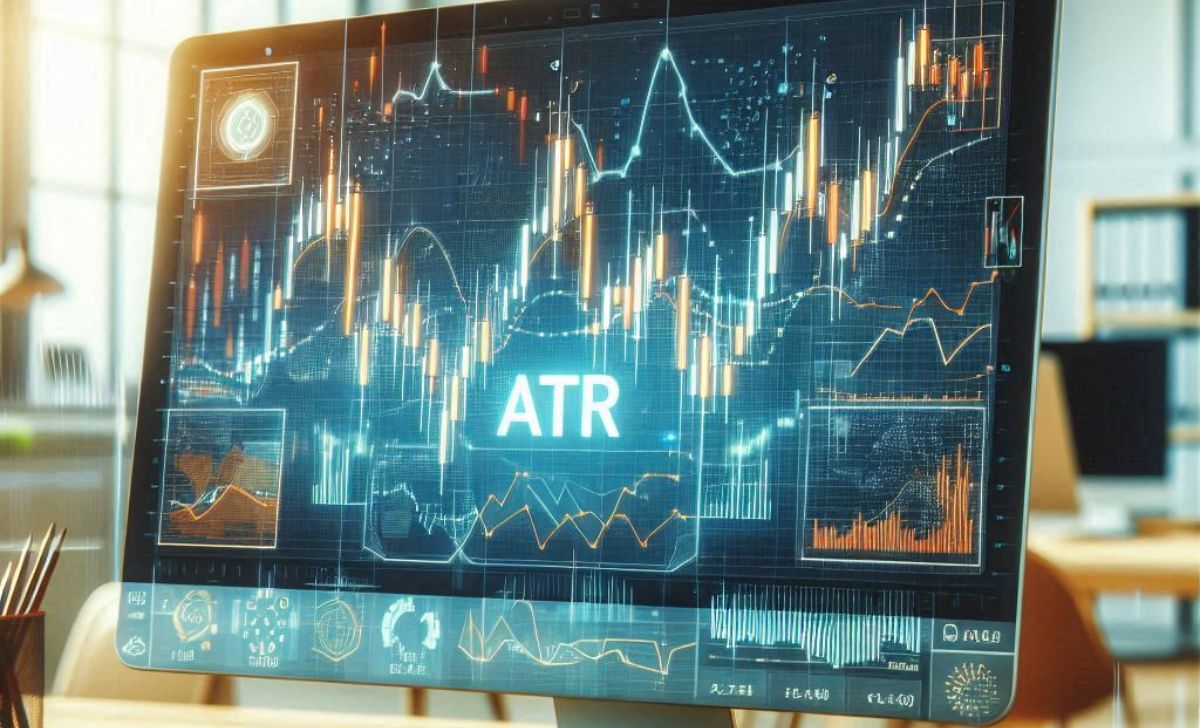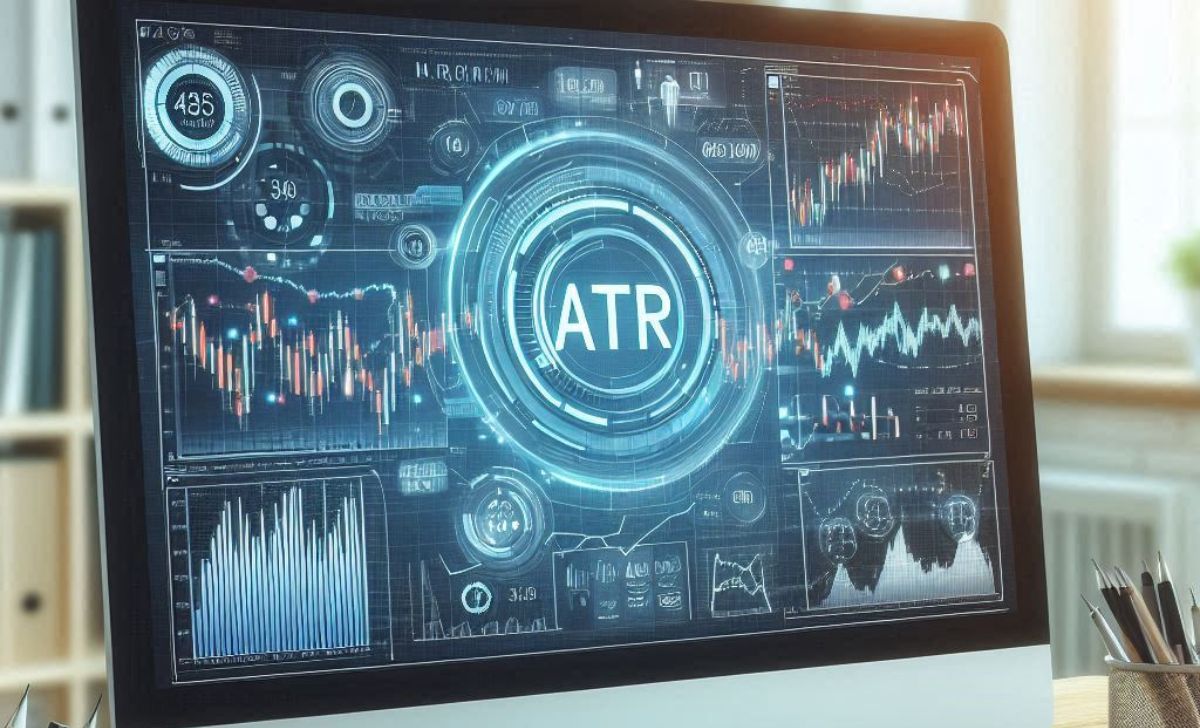The ATR (Average True Range) is a volatility indicator that helps traders measure how much an asset typically moves over a specific period. Unlike indicators that suggest direction, ATR focuses purely on price fluctuation, making it ideal for setting stop-loss levels and gauging market conditions. On XM charts, ATR can be a crucial tool for adjusting your risk based on real-time volatility.
Volatile markets demand smart risk management and ATR can guide you through it. Let’s look at how to apply this indicator effectively on XM.
What Is the Average True Range (ATR) Indicator?

The Average True Range (ATR) is a technical indicator that measures market volatility. Unlike trend-following indicators, the ATR does not indicate direction. Its sole purpose is to quantify how much an asset moves over a given time frame. This makes it a crucial tool for setting stop-losses, identifying market conditions, and managing risk.
Who created the ATR and what is its main function?
The ATR was developed by J. Welles Wilder Jr., the same analyst who created the Relative Strength Index (RSI) and Parabolic SAR.
-
It was originally introduced in Wilder’s 1978 book, New Concepts in Technical Trading Systems.
-
Although it was first applied to commodities markets, ATR is now widely used in forex, stocks, and crypto trading.
Main function of ATR:
-
Measure volatility of the average range of price movement within a period.
-
Help traders determine:
-
Volatility-based stop-loss placement
-
Position sizing
-
When markets are calm vs. highly active
-
Importantly, ATR doesn’t indicate whether price will go up or down only how much it is likely to move.
How is the ATR calculated mathematically?
The ATR is based on a concept called True Range (TR), which accounts for price gaps and overnight movements.
Step 1: Calculate the True Range (TR):
For each period, TR is the greatest of:
-
Current high – current low
-
|Current high – previous close|
-
|Current low – previous close|
This ensures all types of price movement, including even large gaps.
Step 2: Calculate the ATR:
ATR is the moving average of TR values over a set number of periods (typically 14):
ATR = (Previous ATR x (n – 1) + Current TR) / n
Where n is the number of periods (commonly 14).
This calculation creates a smoothed volatility value that adapts over time.
How does ATR reflect volatility without indicating direction?
The ATR is direction neutral. It doesn’t care if price is going up or down only how far it’s moving.
-
A rising ATR means the market is experiencing larger price swings (higher volatility).
-
A falling ATR indicates smaller moves and quieter markets (lower volatility).
-
Whether the market is trending up or down, ATR increases when candles become longer or gaps widen.
This makes ATR ideal for:
-
Setting stop-loss distances that adapt to market conditions
-
Avoiding trades during low-volatility periods
-
Confirming breakout strength (high ATR during breakout = more likely to sustain)
What is the typical ATR period used in forex or stock trading?
The standard period for ATR is 14, as originally suggested by Wilder.
-
In daily charts, this means ATR calculates the average range over the last 14 days.
-
In forex, traders may also use shorter timeframes (e.g., 5 or 10) for intraday strategies.
-
For longer-term trading, periods like 20 or 21 may be used to align with weekly cycles.
Some examples:
| Market Type | Common ATR Period |
| Forex Day Trading | 10 – 14 |
| Stock Swing Trading | 14 – 21 |
| Long-Term Investing | 21 – 50 |
Traders often experiment with different ATR settings depending on their strategy, asset class, and timeframe.
Is ATR a Reliable Measure of Market Volatility?

The Average True Range (ATR) is widely regarded as a reliable volatility indicator, especially for traders who need a responsive tool to gauge price fluctuations. The ATR has been a staple in technical analysis for decades due to its flexibility across various trading styles and asset classes.
Can ATR detect high or low volatility phases?
Yes. ATR is specifically designed to highlight whether the market is experiencing high or low volatility.
-
When ATR rises, it signals an increase in price range often due to strong trends, breakouts, or major news events.
-
When ATR falls, it reflects a period of market calm or consolidation, such as sideways movements or narrow trading ranges.
Because ATR captures both intraday range and price gaps (via True Range calculation), it responds faster and more accurately than a simple high-low difference.
Use cases:
-
Trend traders watch for rising ATR as confirmation of momentum.
-
Range traders may prefer declining ATR, indicating lower volatility.
Is ATR more accurate than simple range or standard deviation?
Generally, yes. ATR offers a more responsive and realistic measure of volatility than a basic range or even standard deviation under certain conditions.
Compared to the simple range (High – Low):
-
ATR accounts for gaps between periods (e.g., overnight gaps in stocks or gaps at news releases).
-
It uses the True Range, which includes the largest possible move between current and previous bars.
Compared to standard deviation:
-
Standard deviation measures statistical dispersion, often used in Bollinger Bands or risk models.
-
ATR is more direct and easier to interpret, especially for real-time stop-loss placement and volatility filtering.
-
ATR adapts faster in fast-moving markets, whereas standard deviation can lag slightly due to squared calculations.
So while both are useful, ATR is often preferred by discretionary traders for practical trading decisions.
Does ATR work equally well in all asset classes?
ATR is effective across most asset classes, but results may vary depending on market structure and behavior:
| Asset Class | ATR Reliability | Notes |
| Forex | High | 24-hour trading, ATR adapts well to volatility shifts |
| Stocks | Moderate–High | May require adjustments due to gaps and earnings volatility |
| Commodities | High | Works well in trending or seasonal markets |
| Crypto | Varies | Volatility can be extreme; ATR may need tuning |
| Indices | Moderate | ATR works well during macro events or trend periods |
In crypto and low liquidity assets, ATR might spike unpredictably. Traders in these markets often combine ATR with volume or trend filters to avoid false signals.
How to Use the ATR on XM MT4 or MT5 Platforms?

The Average True Range (ATR) indicator is built into both MetaTrader 4 (MT4) and MetaTrader 5 (MT5) on XM’s trading platforms. Whether you’re measuring market volatility or setting stop-loss levels, ATR is a valuable tool and setting it up is easy.
How to add the ATR indicator in XM’s MetaTrader interface?
To begin using ATR, follow these steps within your XM MT4 or MT5 terminal:
-
Open a chart of the asset you want to analyze (forex, stock, commodity, etc.).
-
On the top menu, click on “Insert” → “Indicators” → “Oscillators” → “Average True Range”.
-
The ATR settings window will appear. You can leave the default period (usually 14) or modify it as needed.
-
Click OK, and the ATR line will appear below your price chart.
Tip: You can also drag ATR directly from the “Navigator” panel on the left side under “Indicators” → “Oscillators”.
What settings can be customized (period, visualization)?
XM allows full customization of ATR settings to match your trading style:
-
ATR Period: The default is 14 (Welles Wilder’s original setting), but:
-
Use shorter periods (7-10) for more sensitive signals.
-
Use longer periods (20-21) for smoother, longer term volatility tracking.
-
-
Visualization:
-
Change the color, line thickness, and style to make the ATR line more visible.
-
You can apply ATR to specific timeframes only using the “Visualization” tab.
-
These customizations help adapt ATR to scalping, swing trading, or long term investing.
Can ATR be paired with alerts or EA automation?
Yes. ATR can be paired with alerts and integrated into Expert Advisors (EAs) for automation and advanced risk management.
For alerts:
-
Use third-party ATR indicators that include volatility alerts (e.g., alert when ATR exceeds a defined threshold).
-
Alternatively, create custom scripts or use trading panels that notify you when ATR rises or falls sharply.
For EAs (Expert Advisors):
-
Many XM-compatible EAs use ATR to:
-
Dynamically set stop-loss/take-profit levels based on market volatility.
-
Adjust position sizes to maintain consistent risk.
-
Filter trades (e.g., only enter trades when ATR is above a minimum level).
-
If you’re using XM’s VPS service, running ATR-based EAs around the clock is highly effective — especially in volatile markets.
How to Trade Using ATR as a Volatility Tool?

The Average True Range isn’t just an indicator of volatility it’s a tactical tool for managing position size, defining stop-loss levels, and even timing breakouts. By using ATR intelligently, traders can adapt their strategies to changing market conditions and improve risk-adjusted returns.
How to use ATR to size positions (e.g., fixed risk in pips)?
Position sizing based on ATR helps ensure consistent risk across trades, regardless of volatility. Here’s how to use it:
-
Determine your risk per trade (e.g., $100).
-
Find the ATR value on your chosen timeframe let’s say the ATR(14) is 50 pips.
-
Decide your stop-loss multiple (commonly 1x to 1.5x ATR). For instance, 1.5 x 50 = 75 pips stop-loss.
-
Use a position size calculator or this formula: Position Size = Risk Amount / Stop-loss (in pips)
Example: If risking $100 with a 75-pip stop-loss, your position size = $100 / 75 = 1.33 USD/pip.
This approach automatically reduces position size in volatile markets and increases it when volatility is low, preserving account equity.
How to use ATR to set stop-loss and take-profit levels?
ATR offers dynamic and market sensitive exits, which are often superior to fixed pip values. Here’s how:
-
Stop-loss using ATR:
-
Place your stop-loss 1x to 2x ATR away from your entry to account for noise.
-
For example, if ATR = 40 pips, a 1.5x buffer = 60 pips stop-loss.
-
-
Take-profit using ATR:
-
You can use multiple ATR for TP, such as 2x or 3x ATR, depending on your desired risk-reward ratio.
-
Alternatively, use ATR to set a trailing stop, where your SL moves as ATR-based volatility expands or contracts.
-
Example:
Enter a long trade with ATR = 30 pips.
-
SL = 1.5 * ATR = 45 pips
-
TP = 3 * ATR = 90 pips
This gives you a 2:1 reward-to-risk setup, customized to current volatility.
How to build breakout or trend strategies using ATR spikes?
ATR spikes can be powerful signals of impending volatility expansion ideal for breakout or trend strategies.
Strategy example:
-
Identify a consolidation zone or chart pattern (triangle, rectangle, flag, etc.).
-
Monitor ATR — when it starts to rise from low levels, it suggests volatility is returning.
-
Set a pending order (buy stop/sell stop) slightly above/below the range.
-
Trigger entry only if ATR exceeds a certain level (e.g., ATR > 20-period moving average of ATR).
-
Use ATR-based SL/TP to manage trade.
This filters out false breakouts and helps enter only when the market is “waking up”.
Bonus tip: Combine ATR with volume spikes or momentum indicators like RSI or MACD for even stronger confirmation.
Is ATR Suitable for All Types of Traders?

The ATR is often seen as a volatility gauge, but its versatility extends across various trading styles from short term scalping to long term investing. Let’s explore whether ATR truly fits all trader profiles.
Can scalpers and intraday traders use ATR effectively?
Yes, ATR can be extremely effective for scalpers and intraday traders. On lower timeframes (e.g., M1, M5, M15):
-
ATR helps assess short-term volatility to avoid entering during choppy, low-movement periods.
-
It allows traders to adjust stop-loss and take-profit levels dynamically, ensuring trades aren’t prematurely closed by noise.
-
Scalpers may even use micro-ATR values (e.g., ATR(5)) for pinpoint accuracy.
For intraday traders, ATR helps identify high-volatility windows, such as market opens or economic releases, improving trade timing and decision-making.
Does ATR work better in trending or ranging markets?
ATR itself is non directional it measures volatility, not trend direction. However:
-
In trending markets, ATR helps identify momentum strength. Rising ATR alongside price movement often signals a strong, sustainable trend.
-
In ranging markets, declining ATR helps confirm consolidation phases, helping traders avoid false breakouts or prepare for future volatility expansions.
So, ATR is reliable in both market types, but its interpretation changes:
-
Use ATR growth as a trigger in trend strategies.
-
Use ATR contraction as a filter in range-bound or breakout anticipation setups.
Can long term investors use ATR for portfolio-level risk control?
Yes, ATR is not limited to short-term trading. Long term investors and swing traders can use ATR to:
-
Position size appropriately across multiple assets, ensuring consistent risk exposure.
-
Detect unusual volatility spikes in individual stocks or assets, which may warrant rebalancing or hedging.
-
Adjust trailing stops dynamically in long-term trend-following strategies (e.g., 14-day ATR on daily or weekly charts).
For portfolios, ATR can be part of a volatility budgeting system, where more volatile assets are allocated less capital enhancing overall risk-adjusted performance.
The ATR indicator provides traders with a practical edge by revealing how much the market is likely to move. This allows for smarter position sizing, dynamic stop-loss placement, and better adaptation to changing volatility. When integrated into your XM trading strategy, ATR becomes a valuable ally in balancing risk and reward more effectively, especially for those who want to learn trading through hands-on application of risk management techniques.

Lina Vexley is a forex education specialist with a passion for guiding new traders. She offers step-by-step lessons on MetaTrader and risk control, making XM accessible and practical for traders of all experience levels. Email: [email protected]

 Tiếng Việt
Tiếng Việt
